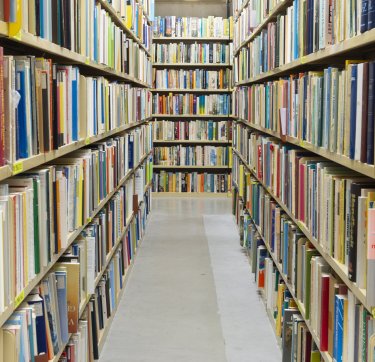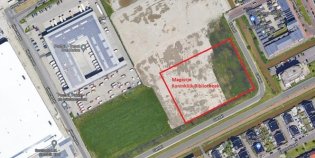Frequently asked questions about our new repository
The KB is set to build an innovative, new book repository in which the National Library will store the Netherlands’ printed and written heritage safely and sustainably for the long term. Read the frequently asked questions about the new repository.
A study carried out in 2016 revealed that as our building was out-of-date and in need of renovation, a new building would be the best and most economical solution. In addition, we need a new repository for our ever-growing national library collection.
Our collection will be moved into an automated book repository in the Harnaschpolder district of the municipality of Midden-Delfland. Due to the historical ties with the city, the public library building will remain in The Hague, but the exact location is as yet unknown.
If everything goes according to plan, the new repository should be fully operational by 2028. The new main library building will be completed around 2030.
A repository with special features is being built in order to preserve our collection securely and sustainably for future generations. A building with special requirements like this one cannot be developed in the centre of The Hague. Therefore the decision was made to separate the two buildings.
We store some 120 km of printed heritage. This means literally millions of books, newspapers and magazines. The KB repository stores one copy of everything that has ever been written in or about the Netherlands. The collection is an essential part of our collective memory of Dutch history and culture, which is why we need to take such good care of it.
The greatest risks facing the collection at the moment are fire and flooding. These risks are practically ruled out in the new repository: the low level of oxygen in the air makes fire impossible, and because the climate will be regulated passively, there will be no water-bearing climate system that can cause water damage. In addition, the repository will be built on an artificial two-metre-high mound to protect the collection from flooding.
The shelves in the new repository will be higher than at present, so that more books can be stored. Robots will move between the shelves, picking up and returning books that have been requested. This method has been tried and tested in other foreign libraries. For example, ten years ago, the British Library moved 200 km of books to a robot repository, and in 2016, Switzerland opened a fully automated library (the Speicherbibliothek) in Büron.
In principle, nobody will work in the storage section of the new automated book repository, but people will obviously be able to go in if there are faults or failures in the robot system. There will also be an office attached to the repository, where the oxygen level will be normal and people can work in a safe and healthy environment.
No, nobody will be fired. The work practice of certain colleagues will alter after the new repository becomes operational. We will roll out the new working methods for the staff concerned over the next few years.
We will take measures to minimise the impact of vibration or bumping during transport. Fragile material will be carefully packaged, for example. The heritage sector has already accumulated a wealth of knowledge about this, and collections are transported safely every day. Of course another important aspect is that security must be in place. Measures will also be taken in this respect.
The separation of the public building and the repository will not affect the KB’s visitors. They will still have to request material from the collection in advance, and view it in the public library building, as they do now.
No. In fact this is the third time that the collection will move to a new location. In 1798, the National Library was housed in several rooms of the former stadtholder’s wing of the Binnenhof. In 1807, the collection was moved to the Mauritshuis, and in 1821, the KB moved to Lange Voorhout, where it remained for over 150 years. The last move was in 1982, when the KB relocated from Lange Voorhout to the current premises on Prins Willem Alexanderhof.
De exacte hoogte overlegt het Rijksvastgoedbedrijf met experts en met de gemeente. De verwachting is dat het gebouw, gezien de omvang van het boekenopslagsysteem, hoger wordt dan het bestemmingsplan toelaat. De komende maanden vindt meer onderzoek plaats naar de exacte hoogte en de ligging van het gebouw vanaf de huizen.
We begrijpen de vragen en eventuele zorgen die er zijn over de hoogte van het gebouw. Daarom wordt zorgvuldig gekeken hoe we het uitzicht en lichtinval van omwonenden kunnen behouden of zo minimaal mogelijk veranderen. Daarbij wordt gekeken naar de plaatsing van het gebouw op de kavel, om zo te voorkomen dat de hoogte leidt tot extra schaduwwerking.
Het magazijngebouw bestaat voor het grootste gedeelte uit de logistieke robotinstallatie waarin de collectie wordt opgeslagen. Om te zorgen dat de collectie droog blijft (gezien de lage ligging van de polder), wordt de begane vloer van het gebouw met 2 meter verhoogd.
Het gebouw zal zo ver als mogelijk van de bestaande bebouwing af worden geplaatst, gezien de hoogte die nodig is voor het gebouw. Voor de omwonenden, vooral aan de noord-oostzijde, levert het gebouw op deze manier geen extra schaduwwerking op.
We zetten in op kwalitatief hoogstaand ontwerp dat anders is dan de bestaande gebouwen op het bedrijventerrein. Een ontwerp dat past bij de functie van het gebouw. De uitstraling rondom het gebouw is open en natuurlijk. Er komt een sloot en nieuw groen om het gebouw. Hekwerken zijn niet nodig.
Tijdens de verhuizing van de collectie gaat het om 2 vrachtwagens per dag. Na de verhuizing zal er 2 keer per dag een bestelbusje rijden via de Gantel.
Gezien het geringe aantal personeel en gasten is het plan om 14 parkeerplaatsen op eigen terrein te realiseren. Voor het fiets parkeren komt naast de hoofdentree een inpandige stalling.
Nee, publiek kan het gebouw niet betreden.

